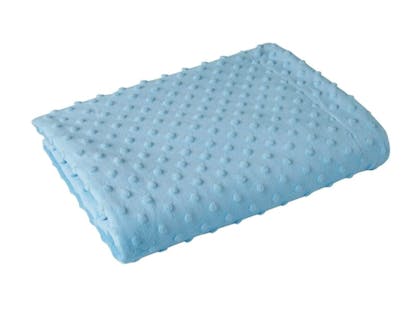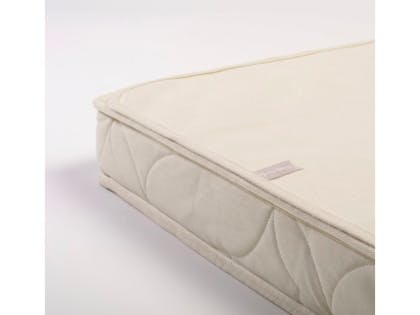best buys
The best bedding for your baby's cot or cot bed

This page contains affiliate links, which means we may earn a small amount of money if a reader clicks through and makes a purchase. All our articles and reviews are written independently by the Netmums editorial team.
It’s easy to be seduced by gorgeously designed baby bedding, but when buying baby bedding you have to think practically too, finding out whether it’ll fit your chosen cot or cot bed for example, and of course thinking about safety, as pillows, quilts and duvets should only be used once your baby reaches 12 months old. (Scroll down for more advice on safety and sleeping and find out how safe co-sleeping is.) Here, we reveal what you ACTUALLY need for your baby's bedding and our top picks.
- How to buy bedding for co-sleeping
- How often should you change baby bedding? - Advertisement Promotion
Newborn bedding guide
You'll need several things for your baby's bed to keep them safe, dry and comfortable.
- A mattress protector
- A fitted sheet
- A baby sleeping bag or blanket (see important safety note below)
- Other extras should only be used when safe to do so
Coordinated nursery bedding bundles often come with pillowcases, duvet covers and bedspreads. Although these can look lovely in the nursery, you should never give a pillow or duvet to a baby under 12 months, as it increases the risk of cot death.
You can introduce them once your baby turns 1, but until that point, if you want to use them as part of your nursery décor, you must remove them before you put your baby to bed.
Finally, cot bumpers are padded fabric barriers that tie on the inside of the cot bars. These are intended to stop your baby bashing into the cot bars, but they have been associated with accidents when babies are old enough to roll around the cot and entangle themselves in the ties and are not recommended.

1. Anti-Allergy Cotbed Pillow
* Filled with 100% hollowfibre
* Suitable from 12+ months
* Machine-washable at 40 degrees
This cot bed pillow has been designed especially with your little one's comfort in mind. It's lightly filled and gives an extra soft level of comfort to their first bed. It's also designed with an anti-allergy protection core for a soothing, irritation-free sleep for little ones (and added peace of mind for parents)! NOTE: never use a pillow with a baby under 12 months.

2. Organic Fitted Sheet
* Crafted from soft and breathable jersey cotton
* Comes in unbleached white fabric
* Machine washable and tumble-dryer safe
This super soft and stretchy jersey cotton sheet will fit a standard-sized cot bed and is 100% organic. It's made from finely knitted cotton and provides extra breathability and comfort for sensitive newborn skin. It's also machine-washable and tumble-dryer safe. The perfect addition to any eco-conscious home.

3. Clair de Lune Dimple Blanket
* Made using super soft, plush dot dimple fabric
* Designed with cotton jersey lining for maximum comfort
* Suitable for use from birth
This pretty blanket is ideal to use in cots, prams, Moses baskets and strollers. Made from a super soft dimple-textured fabric that's lined with cotton jersey for added softness, it will keep baby skin irritation-free and cosy. It also makes an amazing gift and comes in a wide range of colours to choose from.

4. Duvet Cover and Pillowcase Set
* Features a cool and contemporary design
* Crafted from a super soft cotton-blend (52% polyester, 48% cotton)
* Machine-washable, tumble dryer-safe and quick drying
Designed to fit a regular-sized toddler duvet and pillow, this stylish bedding set is suitable from 12 months. Combining a neutral colour palette with a classic star print, it will bring a contemporary twist to any room. And, as another plus, it's reversible with an alternating grey and white print for added value.

5. Swaddle Blankets
* Crafted from soft muslin cotton
* Light, open weave makes them breathable
* Large, multitasking size, makes them ideal to use as a changing mat, bib or car seat liner
Swaddling a newborn helps them to feel more secure, so they'll hopefully sleep more deeply - and for longer too!
This large swaddle blanket will feel silky soft against delicate baby skin and is made with an open weave which makes it more breathable, preventing your little one from overheating. A must for every mum's newborn kit.

6. The Little Green Sheep Organic Mattress Protector
* Made from breathable and extra absorbent organic cotton
* 100% waterproof keeping your baby clean and dry
* Can be machine washed for added practicality
This mattress protector is washable at 40 degrees, plus you can pop it into the tumble dryer too, so it can easily cope with the spills and dribbles of newborn life. It also allows your mattress to breathe from the sides and underneath whilst also creating a dust mite barrier. A must-have for creating a safe sleeping environment for little ones and prolonging their mattress's life.

7. The Original Gro Bag Sleeping Bag
* Features a chic unisex design
* Designed with nickel-free popper fastenings and a zip to the bottom
* Suitable for warmer rooms and the summer months
A sleeping bag can sometimes be a better alternative to blankets and sheets as it won't be kicked off during the night, causing your baby to wake up because they're cold. This set of two is ideal for warmer temperatures and has a 1 tog weight. It's also conveniently designed with popper fastenings and zip to the bottom for easy nappy changing. It's suitable from birth and can be used for the first six months.
What to spend
How much you spend on your baby’s bedding will vary depending on what you buy and where you shop.
Plain white or coloured bed linen can cost from as little as £2 per item from supermarkets and budget-friendly high street stores.
Baby sleeping bags start from around £10, and coordinated bedding sets can easily cost £100 if you buy a complete package.
At the luxury end of the market, even a single cashmere blanket could set you back as much as £100.
Tips when buying bedding for a babycot
- Buying bedding in a matching set is a good idea, as it can work out a little cheaper.
- Make sure you get enough bedding, as you may need to change it frequently in the night when baby's nappy has leaked, they've spit up or other accidents happen.
- Choose swaddling and baby sleeping bags for younger babies as they offer more security and help them to settle. Swaddling and baby sleeping bags can’t be kicked off, so your baby will sleep more deeply, and for longer periods.
How to make a baby's bed
- Working from the bottom of your baby’s bed upwards, the first thing you’ll need is a mattress protector (unless the mattress already has a waterproof cover), this will protect the mattress from baby sick and nappy leaks.
A basic plastic sheet is the cheapest option, but these tend to make babies sweaty and rustle a lot. Fabric protectors made from layers of absorbent material are more expensive but a lot comfier to sleep on.
- You’ll then need a sheet (top tip: buy lots of these, as you may go through several a night!). They come in different sizes to fit Moses basket, crib, cot or cot bed, and are usually made of a soft fabric like cotton jersey or terry towelling.
Fitted sheets have elasticated corners, making them easy to fit, and they don’t slip around and come untucked as easily. Flat sheets can also be used but are trickier to put on and often get rumpled up.
- If you’re using sheets and blankets, the first layer on top of your baby will be a flat sheet. You can then add a blanket, depending on the temperature in your baby’s room.
Baby blankets are generally cellular (with lots of little holes in them) or fleece; both of these materials are breathable and quick drying. You can buy luxury blankets in fabrics like pure wool, merino or cashmere, but these are harder to wash and dry and are very expensive.
- An alternative to using sheets and blankets is to use a swaddling wrap or baby sleeping bag.
Swaddling wraps are shaped blankets that wrap around your baby’s body and fasten in place with Velcro.
These are only suitable up to about 4 months, but can help little babies sleep more soundly.
About baby sleeping bags
Sleeping bags come in a variety of thicknesses, and are designed to stop your baby kicking off their blanket, getting tangled up in it, or pulling it over their head.
They fit like dungarees, with straps over your baby’s shoulders, and fasten with a zip or poppers.
Not all are suitable from birth, and you’ll need to size up as your baby grows, but many parents swear by them for a good night’s sleep.
Need to know
To reduce the risk of SIDS, the safest place for your baby to sleep is in a cot with no loose bedding or cot bumper.
Your baby should sleep on their back, with feet at the bottom of the cot.
Blankets and top sheets should be tucked in tightly at shoulder height, or you can use a baby sleeping bag.
Remember you’ll need to adjust the number of layers of bedding your baby uses (or the thickness of his sleeping bag) depending on the temperature.
In the height of summer, they may need to sleep in just a nappy with no covers.
The NHS has updated its advice for co-sleeping with your baby – and for the first time, it says there ARE ways to share a bed with your baby safely.
The old advice 'Never to share a bed with your baby' has been removed, and instead a section on 'Be safe if you share a bed with your baby' has been added.
The NHS says that if you share a bed with your baby you should:
- make sure they sleep on a firm, flat mattress lying on their back
- not have any pillows or duvets near them
- not have other children or pets in the bed at the same time
They also say it's important not to share a bed with your baby if they had a low birth weight (less than 2.5kg or 5.5lb) or if you or your partner:
- smoke (no matter where or when you smoke and even if you never smoke in bed)
- have had 2 or more units of alcohol
- have taken recreational drugs
- have taken medicine that causes drowsiness
Find out more about co-sleeping
Read on:
- The best space-saving solutions for a small nursery
- How to shop for nursery bedding
- The best cots and cot beds for babies and toddlers



